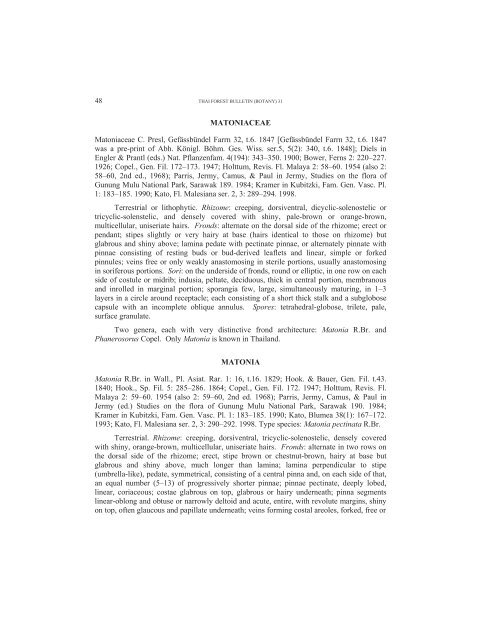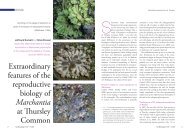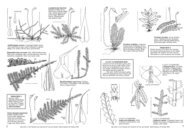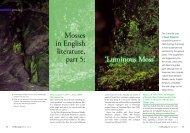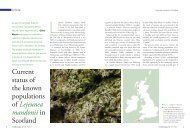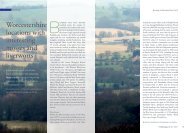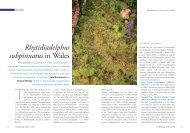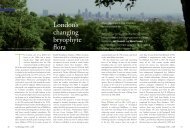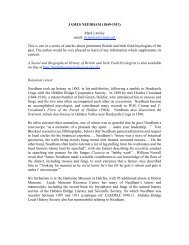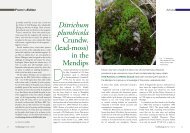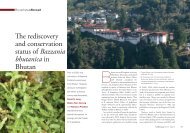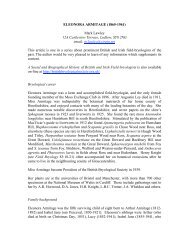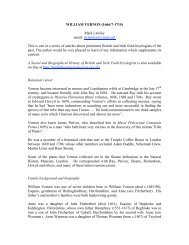Matoniaceae (Pteridophyta) - a new family record for Thailand ...
Matoniaceae (Pteridophyta) - a new family record for Thailand ...
Matoniaceae (Pteridophyta) - a new family record for Thailand ...
You also want an ePaper? Increase the reach of your titles
YUMPU automatically turns print PDFs into web optimized ePapers that Google loves.
48<br />
THAI FOREST BULLETIN (BOTANY) 31<br />
MATONIACEAE<br />
<strong>Matoniaceae</strong> C. Presl, Gefässbündel Farrn 32, t.6. 1847 [Gefässbündel Farrn 32, t.6. 1847<br />
was a pre-print of Abh. Königl. Böhm. Ges. Wiss. ser.5, 5(2): 340, t.6. 1848]; Diels in<br />
Engler & Prantl (eds.) Nat. Pflanzenfam. 4(194): 343–350. 1900; Bower, Ferns 2: 220–227.<br />
1926; Copel., Gen. Fil. 172–173. 1947; Holttum, Revis. Fl. Malaya 2: 58–60. 1954 (also 2:<br />
58–60, 2nd ed., 1968); Parris, Jermy, Camus, & Paul in Jermy, Studies on the flora of<br />
Gunung Mulu National Park, Sarawak 189. 1984; Kramer in Kubitzki, Fam. Gen. Vasc. Pl.<br />
1: 183–185. 1990; Kato, Fl. Malesiana ser. 2, 3: 289–294. 1998.<br />
Terrestrial or lithophytic. Rhizome: creeping, dorsiventral, dicyclic-solenostelic or<br />
tricyclic-solenstelic, and densely covered with shiny, pale-brown or orange-brown,<br />
multicellular, uniseriate hairs. Fronds: alternate on the dorsal side of the rhizome; erect or<br />
pendant; stipes slightly or very hairy at base (hairs identical to those on rhizome) but<br />
glabrous and shiny above; lamina pedate with pectinate pinnae, or alternately pinnate with<br />
pinnae consisting of resting buds or bud-derived leaflets and linear, simple or <strong>for</strong>ked<br />
pinnules; veins free or only weakly anastomosing in sterile portions, usually anastomosing<br />
in soriferous portions. Sori: on the underside of fronds, round or elliptic, in one row on each<br />
side of costule or midrib; indusia, peltate, deciduous, thick in central portion, membranous<br />
and inrolled in marginal portion; sporangia few, large, simultaneously maturing, in 1–3<br />
layers in a circle around receptacle; each consisting of a short thick stalk and a subglobose<br />
capsule with an incomplete oblique annulus. Spores: tetrahedral-globose, trilete, pale,<br />
surface granulate.<br />
Two genera, each with very distinctive frond architecture: Matonia R.Br. and<br />
Phanerosorus Copel. Only Matonia is known in <strong>Thailand</strong>.<br />
MATONIA<br />
Matonia R.Br. in Wall., Pl. Asiat. Rar. 1: 16, t.16. 1829; Hook. & Bauer, Gen. Fil. t.43.<br />
1840; Hook., Sp. Fil. 5: 285–286. 1864; Copel., Gen. Fil. 172. 1947; Holttum, Revis. Fl.<br />
Malaya 2: 59–60. 1954 (also 2: 59–60, 2nd ed. 1968); Parris, Jermy, Camus, & Paul in<br />
Jermy (ed.) Studies on the flora of Gunung Mulu National Park, Sarawak 190. 1984;<br />
Kramer in Kubitzki, Fam. Gen. Vasc. Pl. 1: 183–185. 1990; Kato, Blumea 38(1): 167–172.<br />
1993; Kato, Fl. Malesiana ser. 2, 3: 290–292. 1998. Type species: Matonia pectinata R.Br.<br />
Terrestrial. Rhizome: creeping, dorsiventral, tricyclic-solenostelic, densely covered<br />
with shiny, orange-brown, multicellular, uniseriate hairs. Fronds: alternate in two rows on<br />
the dorsal side of the rhizome; erect, stipe brown or chestnut-brown, hairy at base but<br />
glabrous and shiny above, much longer than lamina; lamina perpendicular to stipe<br />
(umbrella-like), pedate, symmetrical, consisting of a central pinna and, on each side of that,<br />
an equal number (5–13) of progressively shorter pinnae; pinnae pectinate, deeply lobed,<br />
linear, coriaceous; costae glabrous on top, glabrous or hairy underneath; pinna segments<br />
linear-oblong and obtuse or narrowly deltoid and acute, entire, with revolute margins, shiny<br />
on top, often glaucous and papillate underneath; veins <strong>for</strong>ming costal areoles, <strong>for</strong>ked, free or


